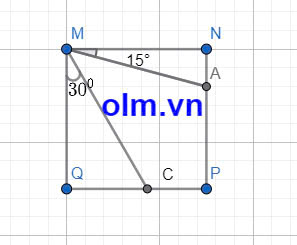\(\frac{8}{27}=\frac{\ldots}{\ldots}x\frac{\ldots}{\ldots}\) như nào ạ ???
Hãy nhập câu hỏi của bạn vào đây, nếu là tài khoản VIP, bạn sẽ được ưu tiên trả lời.


Diện tích khu vườn hình chữ nhật là:
Chiều rộng = \(60\%\) chiều dài = \(0.6\times50m=30m\)
Diện tích khu vườn = chiều dài \(\times\) chiều rộng = \(50m\times30m=1500m^2\)
Diện tích trồng rau sạch = \(\frac23\times\) diện tích khu vườn = \(\frac23\times1500m^2{}=1000m^2\)
Diện tích còn lại để trồng cây ăn quả và hoa = diện tích khu vườn - diện tích trồng rau sạch = \(1500m{^2}-1000m^2=500m^2\)
Diện tích trồng cây ăn quả = \(\frac25\times\) diện tích còn lại = \(\frac25\times500m^2=200m^2\)
Diện tích trồng hoa = diện tích còn lại - diện tích trồng cây ăn quả = \(500m{^2}-200m^2=300m^2\)
Vậy, diện tích khu vườn là \(1500m^2\) và diện tích trồng hoa là \(300m^2\) .

Lúc 2h30p thì lúc đó góc tạo bởi kim giờ và kim phút sẽ có số đo là 120 độ
Lúc 5h30p thì lúc đó góc tạo bởi kim giờ và kim phút sẽ có số đo là 30 độ
Lúc 6h30p thì lúc đó góc tạo bởi kim giờ và kim phút sẽ có số đo là 0 độ
Lúc 9h30p thì lúc đó góc tạo bởi kim giờ và kim phút sẽ có số đo là 90 độ
Lúc 10h30p thì lúc đó góc tạo bởi kim giờ và kim phút sẽ có số đo là 120 độ

Giải:
Lượng muối có trong 400g nước biển là:
400 x 4% = 16(g)
Do chỉ thêm nước vào dung dịch nước biển nên lượng muối có trong dung dịch nước biển sau khi pha loãng vẫn không đổi và bằng lúc đầu là: 16g
Lượng dung dịch nước biển nồng độ muối 2% là:
16 : 2% = 800 (g)
Lượng nước cần thêm để có dung dịch chứa 2% muối là:
800 - 400 = 400 (g)
Kết luận cần thêm vào 400 g nước để có được dung dịch nước biển nồng độ 2%

Giải:
Chia mảnh đất thành các mảnh nhỏ hình vuông có cạnh bằng \(\frac13\) chiều rộng.
Khi đó diện tích cả mảnh đất là: 3 x 5 = 15 lần diện tích hình vuông nhỏ
Diện tích mảnh đất hình vuông nhỏ là:
375 : 15 = 25(m\(^2\))
Vì 25 = 5 x 5
Vậy cạnh mảnh đất hình vuông là: 5m
Chiều rộng mảnh đất hình chứ nhật là:
5 : \(\frac13=15\) (m)
Chiều dài mảnh đất hình chữ nhật là:
15 : \(\frac35\) = 25(m)
Chu vi mảnh đất hình chữ nhật là:
(25 + 15) x 2 = 80(m)
Đáp số: 80m

Olm chào em, cảm ơn đánh giá của em về chất lượng bài giảng của Olm, cảm ơn em đã đồng hành cùng Olm trên hành trình tri thức. Chúc em học tập hiệu quả và vui vẻ cùng Olm em nhé!

Giải:
Phân số chỉ diện tích phần còn lại là:
1 - \(\frac15\) = \(\frac45\)( diện tích mảnh vườn)
Diện tích cái ao là: 4 x 4 = 16(m\(^2\))
Diện tích mảnh vườn là: 16 : \(\frac15\) = 80 (m\(^2\))
Diện tích phần còn lại là: 80 x \(\frac45\) = 64(m\(^2\))
Đáp số: \(64\)m\(^2\)
Còn nhỏ bài dễ như này nên tự làm em ạ, không bị giống anh Trịnh Việt Bách đấy

Olm chào em, với câu hỏi này olm xin hỗ trợ như sau: Khi em tham gia diễn đàn Olm, các em tích cực hỗ trợ các bạn trên diễn đàn hỏi đáp. Mỗi câu trả lời em sẽ được các bạn tích đúng và em được 1 sp. Và nếu câu trả lời của em chất lượng, trình bày khoa học, phù hợp với trình độ người hỏi em sẽ được ctv vip, amin, giáo viên tích đúng và em nhận được 1gp.Cuối tuần sẽ có bảng xếp hạng, căn cứ vào bảng xếp hạng Olm sẽ trao thưởng xu cho em. em có thể dùng xu để đổi quà trên Olm đó là bút, sổ, áo, mũ, thẻ cào điện thoại. Cảm ơn em đã đồng hành cùng olm.




\(\dfrac{8}{27}=\dfrac{4}{9}\times\dfrac{2}{3}\)
8/27=1/9.8/3